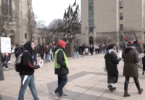By Sara Frazier
From trains to buses to subways, city transportation networks have a larger impact on communities than just getting people where they need to go. At an event Wednesday afternoon, experts said city transportation networks can also further inequality between communities.
The Boston University Initiative on Cities held a seminar called “Getting There: Transportation Vision to Transformative Reality” to address these inequities in transportation and discuss where the city’s current transportation systems might be falling short.
Former Boston Mayor Thomas Menino and Graham Wilson, a professor at Boston University, co-founded the Initiative on Cities four years ago in an attempt to bring together academics and government officials to talk about topics important to the city.
In an interview after the seminar, Wilson said Boston’s public transportation system is inadequate due to the shift toward a more market-driven economy and the implementation of new changes in transportation.
“The challenge is getting the combination of market and government right and adapting to the new changes,” he said. “Anyone who lives or works in Boston knows how critical it is to try to get the transportation system right.”
Katharine Lusk, the executive director of the Initiative on Cities, said the group wanted to learn more about how cities around the country are overhauling their transportation systems. She pointed to Go Boston 2030, an initiative that plans to make transportation improvements in equity, climate responsiveness and economic opportunity in Boston.
“We were really interested in understanding how those plans become a reality,” she said.
The seminar drew a mix of undergraduates, graduate students and faculty from BU, as well as outside practitioners including city planners and researchers.
At the seminar, panelists spoke about “disruptive technologies,” like ride-sharing and automated vehicles.
Terrance Regan, a professor in the City Planning and Urban Affairs program at BU’s Metropolitan College and a planner at the United States Department of Transportation Volpe Center, said ride-sharing platforms tend to isolate low-income residents who might not have access to a smartphone or the money to afford it.
“Uber created a market that didn’t exist before,” Regan said.
Regan said he hoped local officials would address this issue.
“One of government’s strongest roles is to protect those who need protecting,” he said.
Lily Song, a lecturer in Urban Planning and Design at the Harvard Graduate School of Design, said investments in transportation might seem like a good thing, but they also can lead to displacement of longtime residents and intensify mobility gaps.
“As cities are becoming nicer, people who have been there for a long time and who really need to be there are getting pushed out,” she said.
Investments in transit often lead to gentrification, Lusk explained, which can lead to further inequality.
“When you make investments in transit other than buses, neighborhoods can gentrify,” Lusk said. “That spurs development, which also can prompt displacement.”
One of the approximately 20 attendees of Wednesday’s discussion was Marc Older, a planning and development consultant in Boston.
“Boston is too big of a discussion,” Older said. “Different parts of the city have different problems.”
Older pointed to the Boston Commuter Rail’s Indigo Line, which he said “gets very little service.”
The Indigo Line, or the Fairmount Line, was known for having poor service for neighborhoods such as Hyde Park and Dorchester. The Boston Foundation’s Report on the line’s increasing ridership after an upgrade to the tracks and bridges noted that recent advocacy efforts focused on adding service and converting to rapid transit.
The report noted that the area the Fairmount Line serves “has a higher proportion of minority and low income residents than any neighborhoods served by the MBTA Rapid Transit line.”
Lusk said transportation planners need to pay closer attention to neighborhood trends.
“Transportation shouldn’t be planned in isolation of everything else,” she said. “When you think about almost any issue, it affects cities and it affects people who live in cities.”





